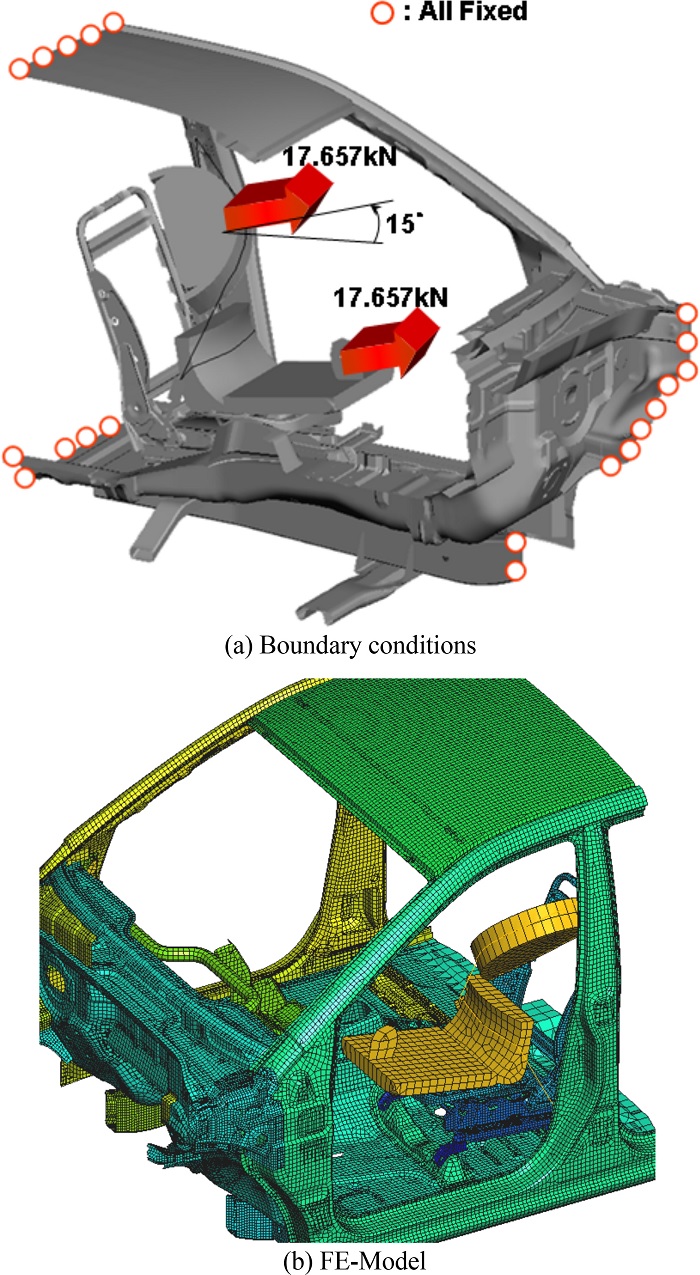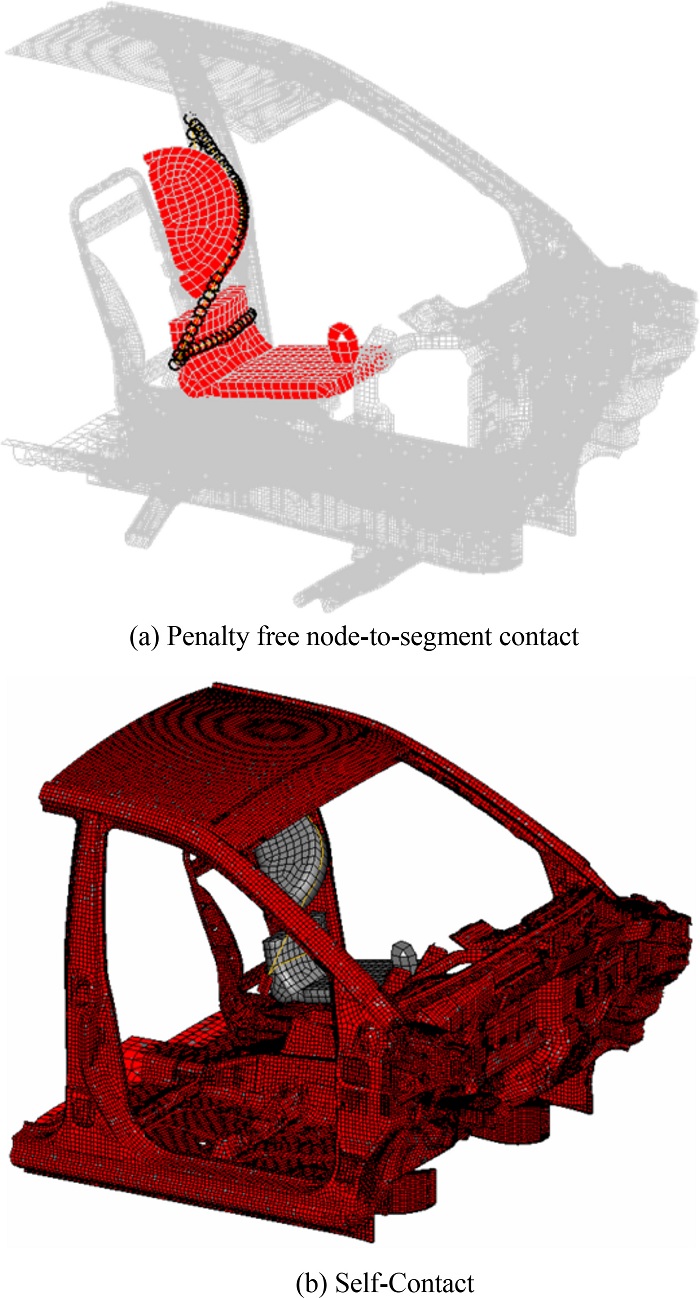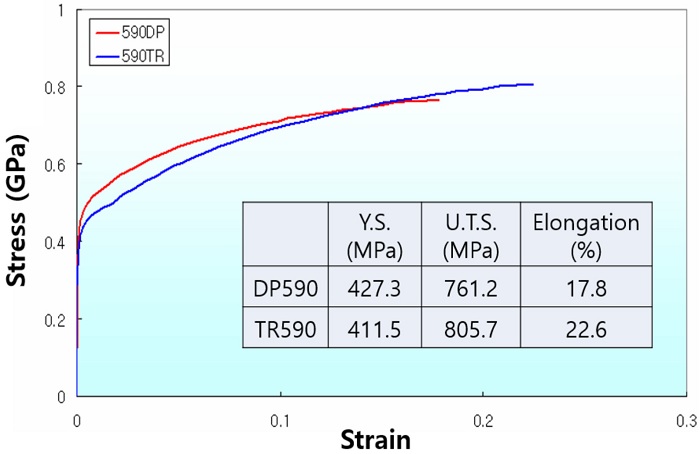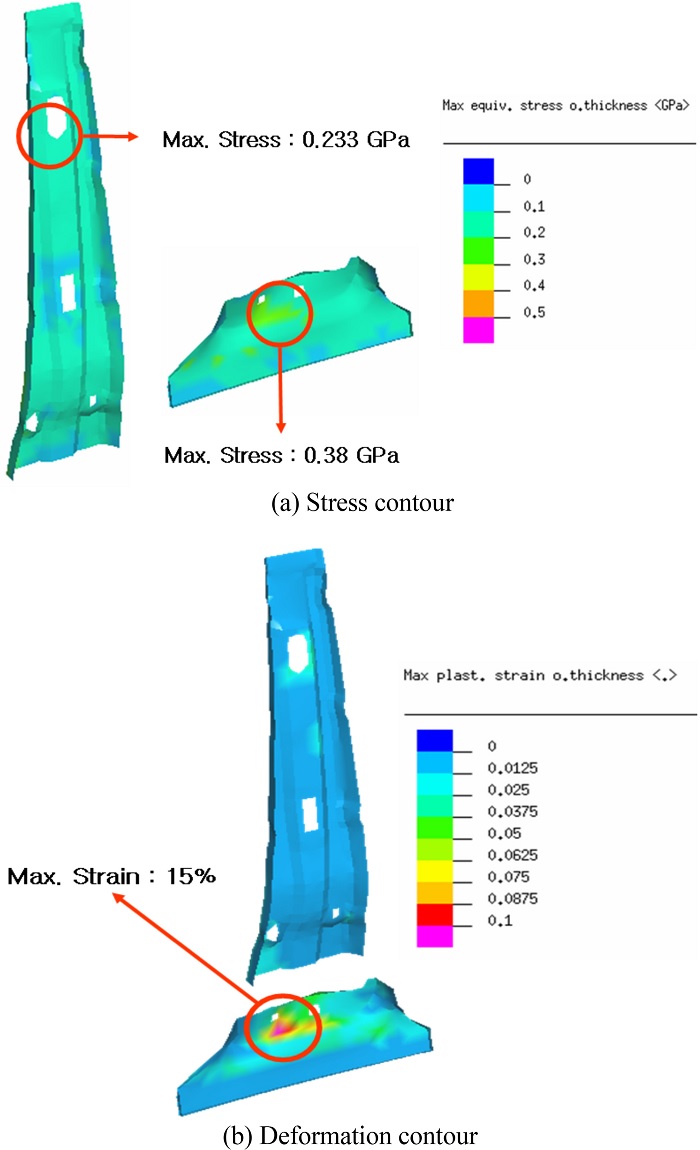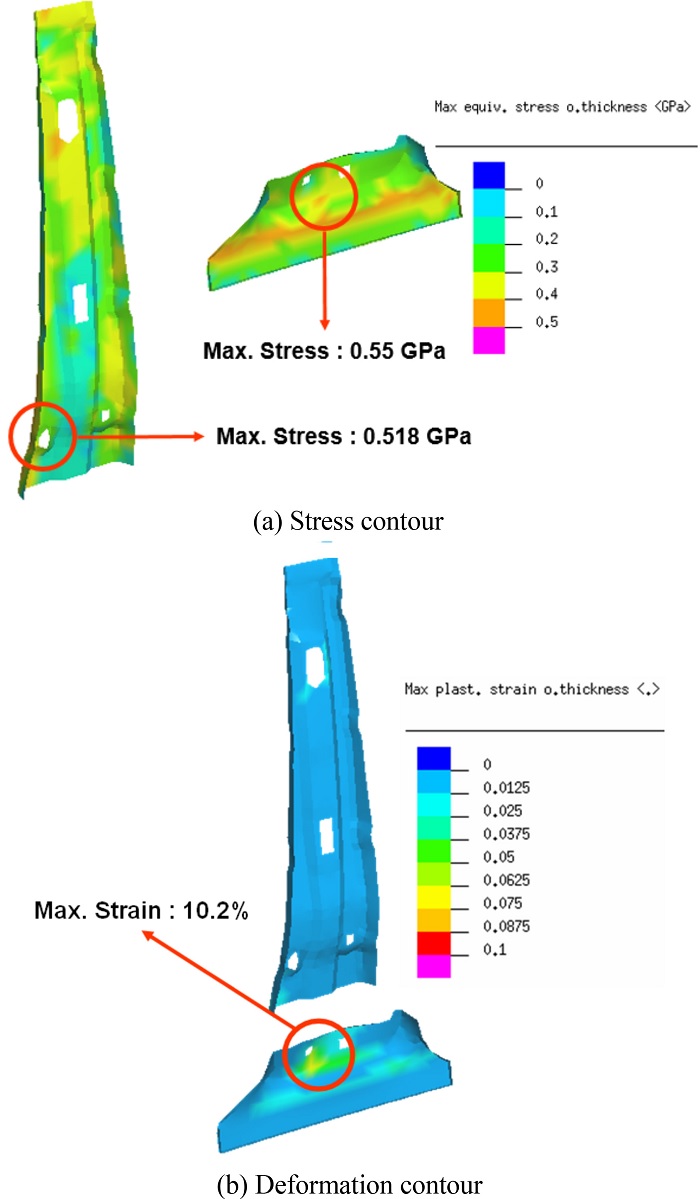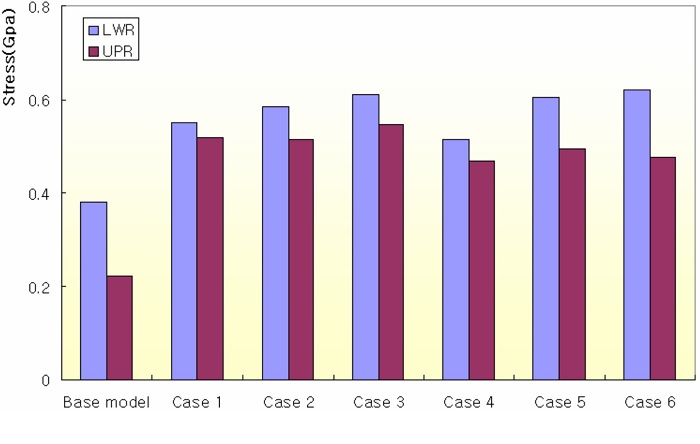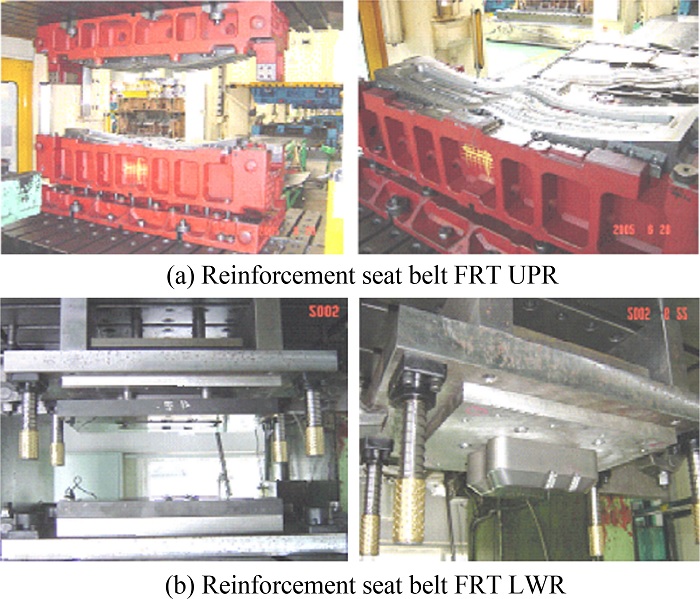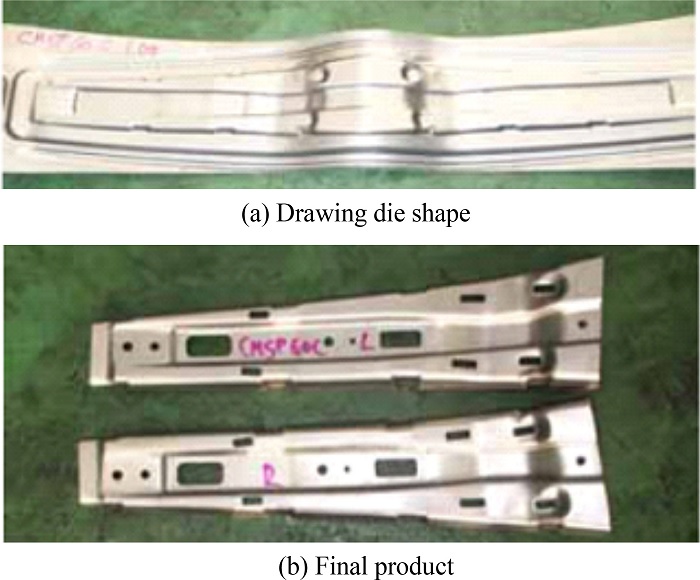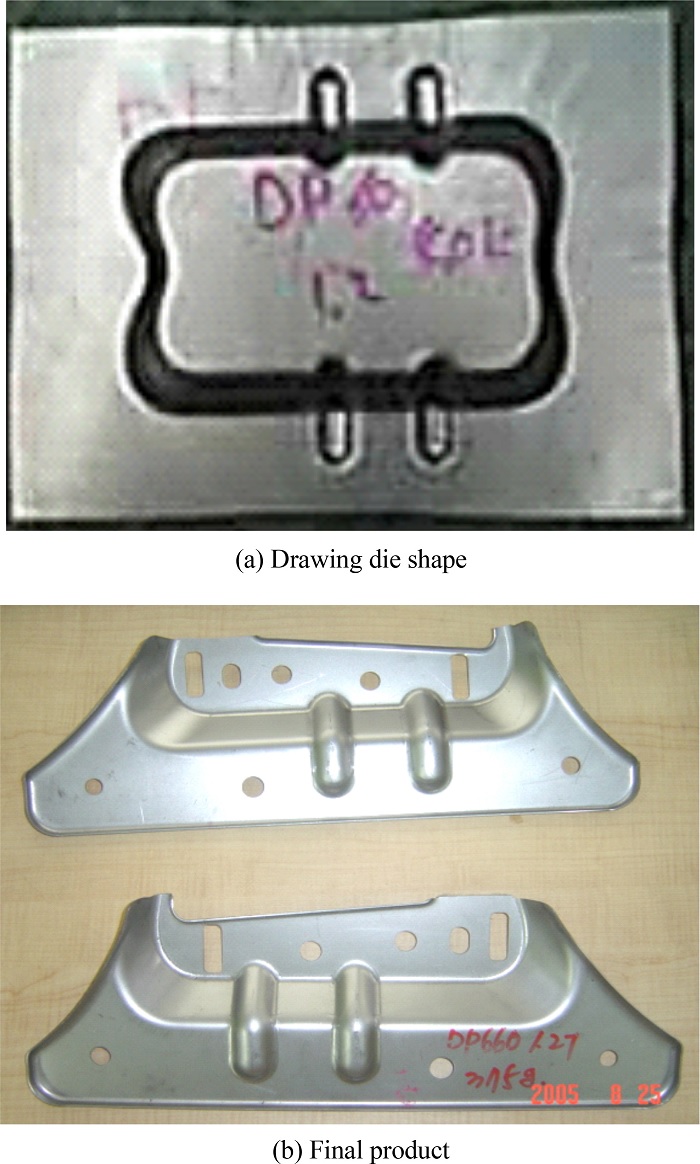
Impact Safety Prediction of Automotive Reinforcement Seat Belt Parts for 590 MPa Grade Materials by Using Computer Simulation
Copyright © The Korean Society for Precision Engineering
This is an Open-Access article distributed under the terms of the Creative Commons Attribution Non-Commercial License (http://creativecommons.org/licenses/by-nc/3.0) which permits unrestricted non-commercial use, distribution, and reproduction in any medium, provided the original work is properly cited.
Abstract
High-strength steel, which has higher strength than ordinary steel, has emerged as a representative lightweight material because of its superior price competitiveness and easy application of manufacturing processes compared to other lightweight materials such as nonferrous metals and sandwich plates. Thus, the purpose of this study was to reduce the thickness and light weight of parts by applying high strength steel more than 600 MPa to various body parts. TR590 and DP590 high tensile steels were applied to the reinforcement seat belt front top and bottom components respectively. To this end, the impact simulation was performed, and the safety of the parts was investigated through FE-Analysis. Prototype molding evaluation confirmed the possibility of mass production of reinforcement seat belt front upper and lower components, using high tensile steel.
Keywords:
Impact safety, Automotive, Reinforcement seat belt, TR590, DP660키워드:
충돌 안전, 자동차, 시트벨트 보강재1. Introduction
Automobile companies in each country are putting all their efforts into developing fuel-efficient technologies such as lightening automobiles and reducing engine friction loss in order to reduce the amount of carbon dioxide generated by automobile exhaust gas through improvement of fuel economy. Accordingly, a design process for lightweighting the rear sub-frame using AA6061 aluminum alloy material with a tensile strength of 310 MPa was studied [1-3]. To reduce vehicle weight, several car makers have applied I-Beams to the link component of the chassis with aluminum alloy material instead of a steel circular beam [4,5].
With the trend toward lighter weight of automobiles and the development of steel sheet material technology, the application of automotive parts to high-strength steel such as DP (Dual Phase) and Transformation Induced Plasticity (TRIP) grades of 590 MPa grade has been gradually expanded from 300-400 MPa grade materials. High-Strength steel is able to reduce the thickness of automobile parts due to its high strength characteristics; and has been recently applied to various automobile parts production. Some researchers have studied about of high-strength DP steels based on the effect of formability investigations, friction stir welding process parameters; and post-weld heat treatment on microstructure and mechanical properties of them [6,7]. In addition, the steel industry has succeeded in developing steel materials with excellent strength, durability, and formability characteristics through various studies in collaboration with automobile companies, and the application of high-strength steel materials to automobiles will continue to expand.
In this study, the possibility of part weight reduction was investigated by replacing the existing SPFC340 (Steel Plate Formability Cold Rolled 340) and SCP1 steel with TR590 and DP590 high tensile strength steels with reinforced formability for the reinforcement seat belt FRT UPR & LWR (Reinforcement Seat Belt Front Upper and Lower) parts. Moreover, the impact safety simulation was carried out for those parts whose material has been replaced.
2. Analysis Methods and Conditions
2.1 Lightweight Target Parts
Fig. 1 shows the shape of the parts to be lightened in this study. The part under study is the part that is joined to the upper and lower part of the B-Pillar located in the middle of the vehicle body as shown in this figure.
2.2 Simulation of Reinforcement Seat Belt FRT & LWR Parts
In this study, to evaluate the reliability of reinforcement seat belt FRT UPR and LWR parts, the analysis of the seat belt assembly anchorages test (FMVSS 210; Seat Belt Assembly Anchorages Test) was conducted according to North American automobile safety standards and Korean automobile safety standards. In the FMVSS 2110 test conditions, a static load of 22.24 kN is applied to a seat equipped with a lap belt system. However, in the case of the seat equipped with the lap and shoulder belt system used in this study, a load of 13.35 kN is applied to the body block. In this study, the mass of the whole seat was 21.95 kg. In addition, when at least one anchor is attached to the seat, 20 times the weight of the seat is applied horizontally by attaching the reinforcement to the cushion frame as shown in Fig. 2(a). Therefore, the total load on the body block was calculated as follows and it was 17.657 kN.
The load direction is 5-15° upward with respect to the horizontal line. At this time, excessive breakage or deformation should not occur in the target part. Fig. 2(b) shows a finite element model with a total of 133,927 elements in the front body, a total of 14,730 elements in the seat structure, and 1,447 elements in the seat belt system.
Fig. 3 shows two contact conditions set in the PAM-CRASH program to prevent interference of each unit. As shown in Fig. 3, the self-contact (Type 36) condition was used to prevent the interference between the body and the seat structure, and the penalty-free node-to-segment contact (Type 31) condition was used to prevent the interference between the belt and the body block.
Fig. 4 shows the time-load curve applied to the analysis. To minimize the dynamic effect, it is assumed that the load condition maintains a constant slope for about 120 msec, and then the load is maintained for 30 msec after reaching 100% load.
Fig. 5 shows the stress-strain curves for the DP590 and TR590 materials used in the analysis. The mechanical properties of the two materials are similar, but the TR590 has excellent elongation and high ultimate tensile strength (U.T.S.). In addition, the DP590 has a slightly low elongation as shown in Fig. 5. Therefore, as can be seen from Fig. 5, it can be seen that in terms of mechanical characteristics, the TR590 material has better toughness than the DP590 material and has a larger work hardening exponent in tensile curves.
3. Analysis Results and Discussion
3.1 Results of Simulation
The seatbelt anchorage test of the model using the existing materials and the model using the high tensile strength steel was analyzed (FMVSS 210). Automotive body, seat structures, and seat belt systems are models that have been verified by actual testing and analysis. This model was analyzed and the impact/crush performance of the model with high tensile steel was evaluated based on the results. In the model using the existing materials, as shown in Fig. 6(a), maximum von Mises stresses of 0.23 GPa occurred in the reinforcement seat belt FRT UPR (Current Material: SPFC340) and 0.38 GPa occurred in the reinforcement seat belt FRT LWR (Current Material: SCP1). Also, as shown in Fig. 6(b), up to 15% of deformation occurred in the reinforcement seat belt FRT LWR.
Fig. 7 shows the analysis results of the case 1 model, which is an improved model by applying high-strength steel to the same thickness as the current model (UPR: 1.2 mm, LWR: 1.4 mm thick). The high tensile steel model showed 0.52 GPa maximum von Mises stress on the reinforcement seat belt FRT UPR parts and 0.55 GPa stress on the reinforcement seat belt FRT LWR parts as shown in Fig. 7(a). Also, as shown in Fig. 7(b), up to 10.2% of deformation occurred in the reinforcement seat belt FRT LWR part.
Table 1 shows the analysis cases, and Fig. 8 shows the comparison of the maximum stress values after the analysis by varying the thickness and material type. As shown in Fig. 8, higher stress occurred in the model to which high tensile strength steel was applied than in the model to which the current material was applied. Since the model to which the high-strength steel was applied did not exceed the fracture strength and showed a low strain rate, it can be seen that the performance was superior to the model to which the current material was applied. In addition, as a result of the analysis, it can be seen that even if the thickness of the model to which the high-strength steel is applied is reduced to 1.0 mm, it shows higher performance compared to the current model.
Applying 1.0 mm high-strength steel makes reinforcement seat belt FRT UPR 16.6% and reinforcement seat belt FRT LWR 28.8% lighter. The maximum stress and the maximum strain were used as the criteria for evaluation, and the models with high tensile steel showed higher performance than the basic design. Comparing cases 1 and 3, it was found that the maximum stress value of case 1, which was also thick, was low. In addition, if cases 4 and 6 are compared, it can be seen that the maximum stress value of case 4, which is also thick, appears low. Summarizing the above results, Table 2 summarizes the strain analysis results for the various cases shown in Table 1.
3.2 Fabrication of Prototype Products
In this study, the formability and quality of high tensile steel parts were evaluated by manufacturing and prototype molding of reinforcement seat belt FRT UPR and LWR. Figs. 9(a) and 9(b) show the forming process using the processed reinforcement seat belt FRT UPR and LWR molds. Reinforcement seat belt FRT UPR molding was formed in each step by drawing (1,000 tons) → trimming (800 tons) → piercing (600 tons) → and separating/flanging/restriking (400 tons) presses. LWR molding was performed on presses of drawing (250 tons) → trim/piercing (200 tons) → bending/burring (200 tons) → separating (160 tons). Fig. 10 shows a prototype of the reinforcement seat belt FRT UPR drawing, as well as a complete product listing and listing and piercing work. The final product is formed without creating defects such as wrinkles or fractures. Fig. 11 shows a prototype of a reinforcement seat belt FRT LWR drawing. Part forming using high-strength steel was performed smoothly. As a result of examining the dimensional distortion of the finished product by using the product inspection tool for the molded high tensile steel parts, there was no dimensional distortion due to spring back. From this, it is expected that mass production of reinforcement seat belt FRT UPR and LWR parts using 590 MPa high tensile strength steel will be possible.
4. Conclusions
(1) The automotive body parts are applied with high-strength steel of 590 MPa class.
(2) When 1.0 mm thick high tensile strength steel is applied to existing 1.2 mm thick products, the weight of reinforcement seat belt FRT UPR is reduced to 16.6%. In addition, the existing 1.4 mm thick reinforcement seat belt FRT LWR was found to be 28.8% lighter.
(3) Reinforcement seat belt FRT UPR molds were successfully formed by applying beads and forming only two stages of drawing and re-striking.
(4) The higher stress occurred in the model to which high tensile strength steel was applied than in the model to which the current material was applied. Since the model to which the high-strength steel was applied did not exceed the fracture strength and showed a low strain rate, it can be seen that the performance was superior to the model to which the current material was applied.
(5) As a result of the analysis, it can be seen that even if the thickness of the model to which the high-strength steel is applied is reduced to 1.0 mm, it shows higher performance compared to the current model.
(6) Dimensional inspection after fabrication of the prototype of reinforcement seat belt FRT UPR and LWR high-strength steel parts showed that there was no dimensional distortion due to spring back.
Acknowledgments
This work was supported by a grant from Tongmyong University Innovated University Research Park (I-URP) funded by Busan Metropolitan City, Republic of Korea (IURP2201).
REFERENCES
-
Kim, K. J., Lee, J. W., (2022), Automotive reinforcement seat belt parts for light-weight design by applying SPFC590 and DP660 high strength steels based on analysis of formability, Materials Science & Engineering Technology, 53(4), 479-484.
[https://doi.org/10.1002/mawe.202100357]

- Kim, K. J., Choi, B.-I., Sung, C.-W., (2008), Hydro-Forming process of automotive engine cradle by computer aided engineering (CAE), Transactions of the Korean Society of Automotive Engineers, 16(1), 86-92.
-
Kim, K. J., Han, C. P., Sung, C. W., Lim, E. J., Choi, B. I., Oh, S., Park, J. H., Won, S. T., Kim, S. S., (2010), Design of an automotive frame cross member for the hydro-forming process using computer aided engineering, Materials Science & Engineering Technology, 41(5), 386-390.
[https://doi.org/10.1002/mawe.201000613]

-
Park, J. H., Kim, S. K., Choi, B. I., Lee, H. J., Lee, Y. H., Kim, J. S., Kim, K. J., (2010), Optimal design of rear chassis components for lightweight automobile using design of experiment, Materials Science & Engineering Technology, 41(5), 391-397.
[https://doi.org/10.1002/mawe.201000614]

-
Kim, K. J., (2020), Mechanical properties evaluation of automotive cross member parts for hydro-formed HF440 materials, Transactions of the Korean Society of Mechanical Engineers A, 44(7), 507-512.
[https://doi.org/10.3795/KSME-A.2020.44.7.507]

-
Tisza, M., Lukács, Z., (2015), Formability investigations of high-strength dual-phase steels, Acta Metallurgica Sinica, 28(12), 1471-1481.
[https://doi.org/10.1007/s40195-015-0346-1]

-
Sisodia, R. P., Gáspár, M., Draskóczi, L., (2020), Effect of post-weld heat treatment on microstructure and mechanical properties of DP800 and DP1200 high-strength steel butt-welded joints using diode laser beam welding, Welding in the World, 64(4), 671-681.
[https://doi.org/10.1007/s40194-020-00867-6]


Professor in the School of Mechatronics Engineering, Tongmyong University. He specialized in Mechanical Engineering in school years. He got Ph.D. award from the School of Material Science and Engineering in Seoul National University. He has the experience to work in Ssangyong Motor Co., Ltd. for about 16 years. There he had been worked on the design of automobile components by using computer-aided engineering based on the finite element method.
E-mail: kjkim@tu.ac.kr

He is a professor in the Department of Automotive Systems Engineering at Joongbu University. He specialized in high-safety automotive in school years, and got his Ph.D. from Kookmin University. He served as a member of the National Technical Qualification Policy Decision Committee at the National Technical Qualification Policy Review Committee for 3 years. He also has 17 years of hands-on experience at GS One, a developer of automotive systems development and automotive training equipment.
E-mail: ljw6677@joongbu.ac.kr


